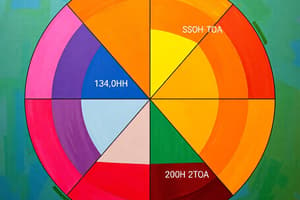Podcast
Questions and Answers
In a right triangle, if $\sin(\theta) = \frac{5}{13}$, and the adjacent side to angle $\theta$ is 12 units, what is the length of the hypotenuse?
In a right triangle, if $\sin(\theta) = \frac{5}{13}$, and the adjacent side to angle $\theta$ is 12 units, what is the length of the hypotenuse?
- 13 units (correct)
- Unable to determine with given information
- 5 units
- 12 units
Given a right triangle where the angle of elevation from point A to the top of a building is 30 degrees, and the horizontal distance from point A to the base of the building is 50 meters, find the height of the building.
Given a right triangle where the angle of elevation from point A to the top of a building is 30 degrees, and the horizontal distance from point A to the base of the building is 50 meters, find the height of the building.
- $\frac{50}{\sqrt{3}}$ meters (correct)
- $50\sqrt{3}$ meters
- 50 meters
- 100 meters
A surveyor stands 100 feet from the base of a building. The angle of elevation to the top of the building is $60^\circ$. Which expression determines the height of the building?
A surveyor stands 100 feet from the base of a building. The angle of elevation to the top of the building is $60^\circ$. Which expression determines the height of the building?
- $100 \cdot \cos(60^\circ)$
- $100 \cdot \cot(60^\circ)$
- $100 \cdot \sin(60^\circ)$
- $100 \cdot \tan(60^\circ)$ (correct)
In a scenario where the angle of depression from the top of a cliff to a boat is $45^\circ$, and the boat is 200 meters away from the base of the cliff, what is the height of the cliff?
In a scenario where the angle of depression from the top of a cliff to a boat is $45^\circ$, and the boat is 200 meters away from the base of the cliff, what is the height of the cliff?
If $\cos(\theta) = \frac{\sqrt{3}}{2}$, what is the value of $\csc(\theta)$?
If $\cos(\theta) = \frac{\sqrt{3}}{2}$, what is the value of $\csc(\theta)$?
A ladder leans against a wall at an angle of $60^\circ$ with the ground. If the foot of the ladder is 4 meters away from the wall, how long is the ladder?
A ladder leans against a wall at an angle of $60^\circ$ with the ground. If the foot of the ladder is 4 meters away from the wall, how long is the ladder?
From the top of a lighthouse 120 feet high, the angle of depression to a boat is $30^\circ$. How far is the boat from the base of the lighthouse?
From the top of a lighthouse 120 feet high, the angle of depression to a boat is $30^\circ$. How far is the boat from the base of the lighthouse?
Solve for $x$: $\tan(60) = \frac{x}{5}$
Solve for $x$: $\tan(60) = \frac{x}{5}$
Given $\sin(\theta) = \frac{1}{2}$ and $\cos(\theta) = \frac{\sqrt{3}}{2}$, what is the value of $\cot(\theta)$?
Given $\sin(\theta) = \frac{1}{2}$ and $\cos(\theta) = \frac{\sqrt{3}}{2}$, what is the value of $\cot(\theta)$?
A right triangle has sides of length 3, 4, and 5. If $\theta$ is the angle opposite the side of length 3, find the value of $2\cos(\theta)$.
A right triangle has sides of length 3, 4, and 5. If $\theta$ is the angle opposite the side of length 3, find the value of $2\cos(\theta)$.
In a scenario where the sine of an angle is known, which trigonometric identity would be most effective in directly finding the cosine of that angle?
In a scenario where the sine of an angle is known, which trigonometric identity would be most effective in directly finding the cosine of that angle?
Given a 30-60-90 triangle, if the side opposite the 60° angle measures $5\sqrt{3}$, what is the length of the hypotenuse?
Given a 30-60-90 triangle, if the side opposite the 60° angle measures $5\sqrt{3}$, what is the length of the hypotenuse?
A surveyor needs to determine the distance across a river. From a point on one bank, they measure the angle of elevation to the top of a cliff on the opposite bank to be 30°. They then move back 100 feet and measure the angle of elevation to be 15°. Without using a calculator, which trigonometric concept is most applicable to solve for the distance across the river?
A surveyor needs to determine the distance across a river. From a point on one bank, they measure the angle of elevation to the top of a cliff on the opposite bank to be 30°. They then move back 100 feet and measure the angle of elevation to be 15°. Without using a calculator, which trigonometric concept is most applicable to solve for the distance across the river?
If $\tan(\theta) = \frac{3}{4}$ and $\cos(\theta) < 0$, what is the value of $\sin(\theta)$?
If $\tan(\theta) = \frac{3}{4}$ and $\cos(\theta) < 0$, what is the value of $\sin(\theta)$?
Consider a right triangle where one acute angle, $\theta$, satisfies the equation $\sin(\theta) = \cos(\theta)$. What implications does this condition have on the triangle's properties?
Consider a right triangle where one acute angle, $\theta$, satisfies the equation $\sin(\theta) = \cos(\theta)$. What implications does this condition have on the triangle's properties?
In the context of vector analysis, how is right triangle trigonometry applied to resolve a vector into its horizontal and vertical components?
In the context of vector analysis, how is right triangle trigonometry applied to resolve a vector into its horizontal and vertical components?
Given that $\csc(\theta) = -2$ and $\frac{3\pi}{2} < \theta < 2\pi$, determine the value of $\cot(\theta)$.
Given that $\csc(\theta) = -2$ and $\frac{3\pi}{2} < \theta < 2\pi$, determine the value of $\cot(\theta)$.
A ladder leans against a wall, forming a right triangle. The ladder is 15 feet long, and the angle the ladder makes with the ground is 60°. How far is the base of the ladder from the wall?
A ladder leans against a wall, forming a right triangle. The ladder is 15 feet long, and the angle the ladder makes with the ground is 60°. How far is the base of the ladder from the wall?
In a mechanical system, two forces are acting on an object. Force A has a magnitude of 20N at an angle of 30° to the horizontal, and Force B has a magnitude of 30N at an angle of 60° to the horizontal. Determine the magnitude of the resultant force's horizontal component.
In a mechanical system, two forces are acting on an object. Force A has a magnitude of 20N at an angle of 30° to the horizontal, and Force B has a magnitude of 30N at an angle of 60° to the horizontal. Determine the magnitude of the resultant force's horizontal component.
You are tasked with designing a roof for a building. The roof needs to have an angle of elevation that maximizes solar panel efficiency, which you've determined to be 40°. If the building is 30 feet wide, and the roof is symmetrical (forming an isosceles triangle), what is the length of one side of the roof (to the nearest foot)?
You are tasked with designing a roof for a building. The roof needs to have an angle of elevation that maximizes solar panel efficiency, which you've determined to be 40°. If the building is 30 feet wide, and the roof is symmetrical (forming an isosceles triangle), what is the length of one side of the roof (to the nearest foot)?
Flashcards
Right Triangle Trigonometry
Right Triangle Trigonometry
Deals with relationships between angles and sides in right triangles using trigonometric functions.
Sine (sin)
Sine (sin)
The ratio of the opposite side to the hypotenuse in a right triangle.
Cosine (cos)
Cosine (cos)
The ratio of the adjacent side to the hypotenuse in a right triangle.
Tangent (tan)
Tangent (tan)
Signup and view all the flashcards
SOH CAH TOA
SOH CAH TOA
Signup and view all the flashcards
Cosecant (csc)
Cosecant (csc)
Signup and view all the flashcards
Secant (sec)
Secant (sec)
Signup and view all the flashcards
Cotangent (cot)
Cotangent (cot)
Signup and view all the flashcards
Angle of Elevation
Angle of Elevation
Signup and view all the flashcards
Angle of Depression
Angle of Depression
Signup and view all the flashcards
Special Right Triangles
Special Right Triangles
Signup and view all the flashcards
45-45-90 Triangle Legs
45-45-90 Triangle Legs
Signup and view all the flashcards
45-45-90 Triangle Hypotenuse
45-45-90 Triangle Hypotenuse
Signup and view all the flashcards
30-60-90: Side Opposite 30°
30-60-90: Side Opposite 30°
Signup and view all the flashcards
30-60-90: Side Opposite 60°
30-60-90: Side Opposite 60°
Signup and view all the flashcards
Trigonometric Identities
Trigonometric Identities
Signup and view all the flashcards
Pythagorean Identity
Pythagorean Identity
Signup and view all the flashcards
Tangent Identity
Tangent Identity
Signup and view all the flashcards
Cosecant Identity
Cosecant Identity
Signup and view all the flashcards
Solving Right Triangles
Solving Right Triangles
Signup and view all the flashcards
Study Notes
- Right triangle trigonometry explores the correlation between angles and sides within right triangles.
- It utilizes trigonometric functions to connect angles with side ratios.
- The main trigonometric functions include sine (sin), cosine (cos), and tangent (tan).
- These functions apply to acute angles inside a right triangle.
Trigonometric Ratios
- Sine (sin) is the ratio of the opposite side's length to the hypotenuse's length, described as sin(θ) = Opposite / Hypotenuse.
- Cosine (cos) represents the ratio of the adjacent side's length to the hypotenuse's length, with cos(θ) = Adjacent / Hypotenuse.
- Tangent (tan) is the ratio of the opposite side's length to the adjacent side's length, given by tan(θ) = Opposite / Adjacent.
- SOH CAH TOA is a mnemonic:
- SOH: Sine = Opposite / Hypotenuse.
- CAH: Cosine = Adjacent / Hypotenuse.
- TOA: Tangent = Opposite / Adjacent.
- Cosecant (csc), secant (sec), and cotangent (cot) are reciprocal trigonometric functions.
- Cosecant (csc) is the reciprocal of sine, noted as csc(θ) = Hypotenuse / Opposite.
- Secant (sec) is the reciprocal of cosine, shown as sec(θ) = Hypotenuse / Adjacent.
- Cotangent (cot) is the reciprocal of tangent, expressed as cot(θ) = Adjacent / Opposite.
Applying Trigonometric Ratios
- Trigonometric ratios determine unknown side lengths in right triangles, provided one angle and one side length are known.
- They also find acute angle measures when two side lengths are known.
- To find an unknown side length:
- Identify the known angle and side.
- Select the trig function that links the known angle and side to the unknown side.
- Formulate an equation and solve for the unknown side.
- To find an unknown angle:
- Identify the known sides.
- Select the trig function connecting the known sides to the unknown angle.
- Use the inverse trig function (arcsin, arccos, arctan) to find the angle.
Angles of Elevation and Depression
- Angle of elevation is measured from a horizontal line upwards to an object.
- Angle of depression is measured from a horizontal line downwards to an object.
- Angles of elevation and depression are complementary when viewed from different elevations.
- These angles are useful in height and distance calculations.
Special Right Triangles
- Special right triangles have specific angles for exact trigonometric values.
- Common special triangles: 45-45-90 and 30-60-90.
- In a 45-45-90 triangle:
- The two legs are equal.
- Hypotenuse is √2 times a leg's length.
- If a leg is x, the hypotenuse is x√2.
- In a 30-60-90 triangle:
- Side opposite 30° angle is half the hypotenuse.
- Side opposite 60° angle is √3 times the side opposite 30°.
- If the side opposite 30° is x, then the side opposite 60° is x√3, and the hypotenuse is 2x.
- Memorization of trigonometric values for 30°, 45°, and 60° is common practice.
Trigonometric Identities
- Trigonometric identities are universally true equations for variable values where expressions are defined.
- Pythagorean Identity: sin²(θ) + cos²(θ) = 1
- This relates sine and cosine.
- sin²(θ) = (sin(θ))² and cos²(θ) = (cos(θ))²
- Quotient Identities:
- tan(θ) = sin(θ) / cos(θ)
- cot(θ) = cos(θ) / sin(θ)
- Reciprocal Identities:
- csc(θ) = 1 / sin(θ)
- sec(θ) = 1 / cos(θ)
- cot(θ) = 1 / tan(θ)
Solving Right Triangles
- Solving a right triangle involves determining all three angles and sides.
- Requires knowing at least one side and one other piece (side or angle).
- Use trig ratios for unknown sides and angles.
- All triangle angles sum to 180°, including right triangles.
- In right triangles, acute angles add to 90° (complementary).
- Pythagorean theorem (a² + b² = c²) finds a side's length from the other two sides.
Applications
- Right triangle trigonometry serves various fields:
- Navigation
- Surveying
- Engineering
- Physics
- Applications:
- Height of structures using elevation angles.
- Distances across water bodies.
- Angle and force calculations in mechanics.
- Vector analysis
Studying That Suits You
Use AI to generate personalized quizzes and flashcards to suit your learning preferences.




